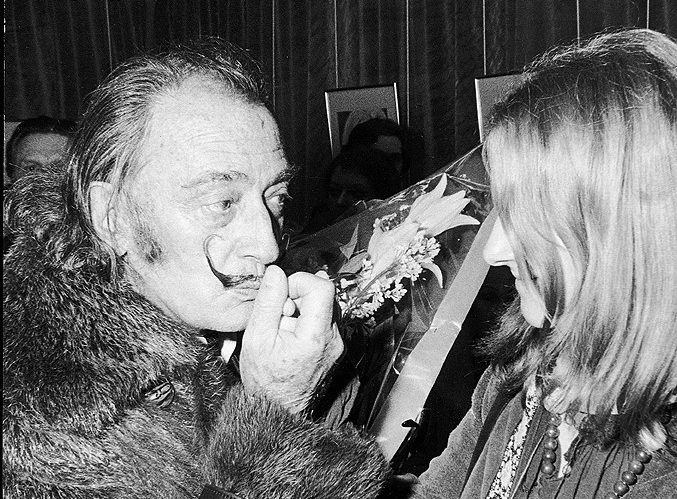Reprinted from Park City Magazine
Boundless creative, technical master, and risk-taker are all apt ways to describe the marvelous and mustachioed Salvador Dalí (born, May 11, 1904; died, January 23, 1989), who remains one of the art world’s most celebrated and iconic figures. Through his unusual paintings, sculptures, and surreal explorations in film and interactive art, Dalí was responsible for ushering in a new generation of imaginative expression. One of his most celebrated images–the melting clocks depicted in his painting The Persistence of Memory–is etched into our collective consciousness. But the workings of Dalí’s mind and his eccentricities are impossibly out of reach for most.
For Madame Christine Argillet, the daughter of Dalí’s close friend and publisher Pierre Argillet, however, Dalí was something of a goofball uncle. The 30-year collaboration between her father and Dalí left Mme Argillet with a treasure trove of memories of the famous artist as he was outside the public arena; she saw the the both temperamental artist and incurable prankster as, perhaps, only a child could. When she was told to sit still and be quiet while she and her parents visited Dalí’s home, the artist noticed and immediately sent her off on a scavenger hunt around his labyrinthine house to find candies inside his crystal jars. “There were huge candies the size of eggs, wrapped in shiny papers and I took them down to the beach and lined them up as Dalí instructed. And they went off, boom, boom and they weren’t candies at all, but cherry bombs,” chuckles Mme. Argillet. “The fishermen were absolutely furious with me and I barely escaped. But Dali thought it was so funny to do things like this.”
Mme. Argillet fondly recalls the summer days her family spent living across from Dalí’s house in Spain, when she’d watch him feverishly etch away at copper plates, constantly experimenting with new techniques and subjects. “Friendship and complicity,” is how Mme. Argillet describes the relationship between her father and Dalí. “They’d have long discussions about the art in process and on literary topics that the artist would illustrate.” It wasn’t always easy, however, to keep up with the rapidly wandering fantasies of Dalí; he often tested the patience of Pierre Argillet. Dalí would, for example, call to say, “I have the plates ready,” for works promised to Argillet. But then Dalí would sell the plates before the publisher arrived and brush off Argillet’s fury with, “I will make you a better print.” On another occasion, Argillet arranged for Dalí to do a copper plate etching demonstration in front of a large audience. The artist showed up, acting somewhat peculiar. After making one round scratch on the plate, he stormed off the stage and, despite Argillet’s threats to cut off his famous mustache, left. Later when Dalí finished the plate for Argillet and the perturbed publisher asked why he not done so at the demonstration, Dalí insisted he recalled almost nothing of the evening, apparently having experimented with LSD after conversing with Timothy Leary.
Despite his notoriety and aptitude for all things unusual, Mme. Argillet insists the private Dalí was actually quite shy and a true workaholic. “He was always experimenting with new techniques, considering things with another angle of perception,” she says. “He would listen as intently to peasant people as he would to scientists and persons of fame and fortune.” Such was Dalí’s infinite fascination with the world, a characteristic which allowed him to renew himself and his work throughout a career that spanned six decades. When asked what she thought Dalí would be pursuing these days, Mme. Argillet is confident it would be in computers and video art, perhaps even delving into virtual reality. Already in the 1970s and ’80s, he was researching 3D art and holograms, and she’s sure he would have wanted to continue being part of the avant-garde in combining science and art.
In addition to Mme. Argillet’s fond remembrances of Dalí, the relationship between her father and the artist also resulted in the unique Argillet Collection, work by Dalí many have never seen, including exquisitely detailed etchings, tapestries, and porcelain plates. Mme. Argillet describes it as, “A tribute to the work of my father as an extraordinary publisher of the Dada and Surrealist group. The collection reflects a constant endeavor and a close collaboration with the artists of these two movements, especially Salvador Dali.”
See The Argillet Collection at Old Towne Gallery
The marvelous Argillet Collection is on display at Main Street’s Old Towne Gallery from March 10th-19th. It is the first time time the collection has has traveled to Utah and a fantastic opportunity to view the work of an artist so acclaimed as Salvador Dalí. Madame Argillet, herself, will accompany the artwork and make special appearances for the public on Friday, March 17th from 7 to 9 p.m.; on Saturday, March 18th from 11 a.m. to 1 p.m. and 7 to 9 p.m.; and Sunday, March 19th from 1 to 3 p.m. Admission is free and open to the public, though an RSVP (435.655.3910 or info@oldtownegallery.com) is required to attend for Mme. Argillet’s visits.

